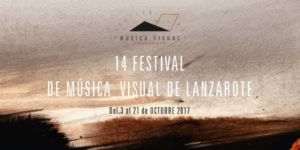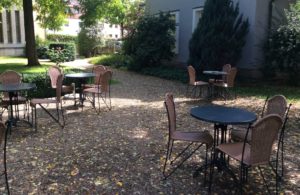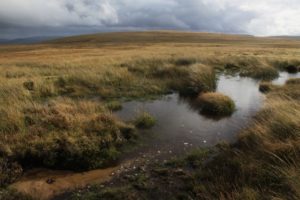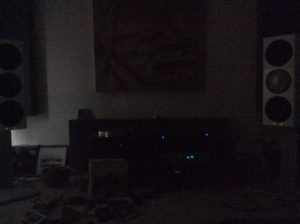Author Archive:
2017 11 Okt.
One of the best fishes of my life, today, grilled, in the restaurant „Amanecer“, Arrieta
Michael Engelbrecht | Filed under: Blog | RSS 2.0 | TB | 15 Comments
2017 9 Okt.
The long radio night on October 21st
Michael Engelbrecht | Filed under: Blog | RSS 2.0 | TB | 2 Comments
I’m too busy on Lanzarote doing nothing in all its different aspects instead of sitting down and write down any more words with the small exception of these ones – I do fall silent for a while, good little Zen exercise, ha! Words interfere with action, words interfere with silence, and I’m too obsessed with silence and action on this island’s remote places than to melt time away with the fabric of thinking in words. So, now being officially invited to two, three exciting „cave concerts“, expecting to meet some handsome shadows from the past, and just being smashed by nice waves at Famara, under the sky blue sky (love that Wilco album!), I take a seat at Las Bajas (waiting for my second cafe con leche), and here it is, the program of my „nighthawk ego“.
The first two hours will lead you to the mountains of Gran Paradiso, to new and forthcoming albums of ECM and Hubro in large numbers, with some surprising „space music“ in between. Outer Space Brass Music, don’t laugh. The third hour will be dedicated to Brian Eno’s four classic song albums of the ’70s. Eno is smart. His is the kind of smartness that can trip itself up through overthinking, or make for art whose interest is mainly formal or „functional“. But he dodged that bullet thanks to his other great obsession, which is giving up his conscious mind’s control. Surrender is the secret code of a breathing system.
And, well, Brian has never been praised enough for finding heartbreaking melodies – the only reason a bunch of his songs became no evergreens is this one: they never hit the charts. The fourth and fifth hour will open up for the time travel department. There will be long passages of three albums played in a row in hour no. four. There will be tracks of three other albums played in special combination within the two parts of hour no. five. There are some good reasons to make Jon Balke’s forthcoming album part of these time travels: his second SIWAN project, out on Nov. 3rd, has a different line-up, but it is so good that you don’t even miss the presence of Jon Hassell!
2017 6 Okt.
Anyone thinking I’ll be playing solitaire at Papagayo?
Michael Engelbrecht | Filed under: Blog | RSS 2.0 | TB | 4 Comments
ANJA LECHNER y FRANÇOIS COUTURIER
11 de octubre. Jameos del Agua, 21:00 h.
Certain things happen with a reason, though we’re good in making sense where pure chance is the real option. I didn’t believe my eyes when reading about edition no. 14 of the Festival Musica Visual de Lanzarote. It happens now, and I’ll be there. Anyone who has ever experienced a concert in the caves of Jameos Del Agua, knows about the fantastic acoustic space. Years and years ago, Brian Eno performed, along with Peter Schwalm, at the bottom of a volcano. Eberhard Weber and David Darling played solo in the very small cave nearby (the walk down there transports memories of reading Jules Verne’s journey to the center of the earth), Bang on a Can performed „Music for Airports“ in James Del Agua and brought the melancholia to the surface that is part of Eno’s classic, but can easily overheared in that kind of „functional music“. The third meeting of the Manafonistas at the break of day has found a perfect afterglow, with two concerts on the opposite sides of intimacy and groove.
NILS PETTER MOLVÆR GROUP
14 de octubre. Jameos del Agua, 21:00 h.
2017 1 Okt.
Songs & Sounds & Atmospheres – Erik Honoré’s „Unrest“
Michael Engelbrecht | Filed under: Blog | RSS 2.0 | TB | 1 Comment
Hubro is my label of the year, this time. Andreas Meland is the man in the background. A programm of excellent, very good, and good works that, in 2017, even surpasses last year’s output of a Nordic / Norwegian spectrum between free improvisation, chamber folk, electric wilderness, altered states of mind & sound, minimal drone studies, post-exotica, songs & sounds & atmospheres. They even put out an album by the band aptly called „1982“, including a church organ being deprived of all its gravitas.
Now Erik Honoré’s second Hubro album ist out, „Unrest“, and, as he has told during bis lecture in Kristiansand about making music in dark and turbulent times, he sees it as the „dark-eyed sister“ of his excellent first solo album „Heliographs“. In fact, it’s a shadowy affair, with a spoonful of atonality and testing the limits of high-pitched violins, free floating, slow piano runs – and a theatre of voices, hiding, murmuring, wondering. Not to forget „The Sheriffs of Nothingness“!
Erik Honore and his companions (yes, a great cast!) know how to build up suspense and release, and the sequence of the tracks is immaculate. You have to listen to it as an album, and, if you want to do yourself a favour, in the dark. While being immersed, you’ll easily be haunted by the thrill of dissonant textures, well placed grooves and swirling melodic lines that happen when you least expect them to appear. The last track is the perfect closer, an apparently simple song with an irresistible tune. And, well, part of the magic of Hubro albums is the cover art of Yokoland (Aslak Gurholt and Thomas Nordby) – for „Unrest“ it works as warning sign – and invitation!
2017 1 Okt.
„Power Spots“ – Mellrichstadt / Dartmoor
Michael Engelbrecht | Filed under: Blog | RSS 2.0 | TB | Comments off
Within the fields of existential, or possibly pagean experience, or even occult spirituality, different physical locations are believed to be holy / existential sites because they possess an access to spiritual (resp. a certain, rarely unearthed human) energy. Common power spots often include mountains, caves, springs, the (often) windstill areas of small village backyards (Mellrichstadt!) – and other locations of unusual natural phenomena.
Recognized power spots are places that intensify whatever people bring to them, so that spending even short periods of time in them can lead to spiritual / existential transformation. Carlos Castaneda was a devoted searcher of power spots. „Power Spot“ is the name of a fantastic record by Jon Hassell, too. Though often connoted with holy places, power spots can sometimes be hardly recognized by their quite ordinary appearance (photo 1).
A good aquaintance of mine nearly lost her life in Dartmoor weeks ago by foolishly undererstimating certain power spot features of an area officially marked with signs of danger. She (a trained post-Freudian therapist) was even warned to enter the moor by a small, „strangely looking“, old woman, but downplayed the advice by thinking she would be kind of foolish. She wasn’t. The result: my aquaintance was white like a ghost after returning very late – for more than half an hour, she thought, every step could be her last.
2017 30 Sep.
„Dream Theory in Malaya“ – two quotes, a cover, and a story (part 2)
Michael Engelbrecht | Filed under: Blog | RSS 2.0 | TB | 5 Comments
In my memory, it was a hot summer afternoon in Schwabing, 1981. There was a record shop in the underground, and I remember, on my regular visits to the city, to stop by and look for exciting new albums. And I remember at least two records I bought there, Egberto Gismonti’s „Solo“ (the material on the cover had a special feel), and Jon Hassell’s „Dream Theory in Malaya“. Both stayed with me ever since.
I had my special Hassell experience, when nearly diving into „Possible Musics“, the Hassell-Eno-collab from the year before, on a never-ending bathtub session in Würzburg, all candles on! So, to hold this album in my hands (I stumbled upon it, didn’t read anything about an imminent release), to look at the surreal Mati Klarwein cover, to see the names of Eno (gongs, bells, bass) and Lanois (mix) on the backside – that all was the perfect ticket to ride.
And this was my first contact with the world of lucid dreaming, Jon Hassell’s story about anthropolgist Kilton Stewart (dating back to 1935, a golden era of Malaysian life, before brutal colonialism left its marks) made it very clear that Freud’s dream theory urgently needed some up-dates from the everyday culture of distant, ancient tribes. Two years later I became a serious student of lucid dreaming, had read the standard books of Stephen LaBerge and Prof. Tholey (the German pioneer).
In this quite short span of time, between early 1981 and early 1983, I lived in a tiny village in the Bavarian wood. This was hard stuff for a townie, and, playing smart Alec, I tried to learn my lessons from Henry David Thoreau. In fact, I learned more from a bunch of records, and „Dream Theory of Malaya“ belonged to the top of the pile. Now, the re-release of the album contains an extra-track, „Ordinary Mind“ (a quite misleading title for such an oceanic piece), offering, 36 years later, an undisputable, perfect ending of that classic.
P.S.: To work as a psychotherapist in Furth i.W. with alcoholics in the early ’80s, following a well-planned research program based on modern extensions of behaviour therapy, seems like a decent first stage of a career in psychology. On the countryside. Looking back, it was a heaven-and-hell ride, including secret road maps, love and desaster, witches and shins and hypocrites, mushrooms, dragons and, well, volleyball. Not to forget the first, very raw album of the Go-Betweens, „Send Me A Lullaby“.
2017 29 Sep.
Mellrichstadtblues
Michael Engelbrecht | Filed under: Blog | RSS 2.0 | TB | Comments off
Ich wäre noch tiefer in die Rhön gefahren, aber nach der Begegnung mit einigen Pilzsuchern in teilweise Handke’schem Outfit (habe ich je verraten, dass Pfifferlinge meine Lieblingspilze sind?), und einem Besuch einer geschätzten Lautsprechermanufaktur, wollte ich nur noch meine 800-Kilometer-Tour durchziehen, als ich plötzlich doch den kleinen Hunger verspürte. Leider hatte das leise vor sich hin sinnierende Örtchen Mellrichstadt schon am Mittag Marktplatz und Bürgersteig hochgeklappt, und es bedurfte einiger Pfadfindertugenden, noch eine offene Pforte ausser der des lokalen Beerdigungsinstitutes zu finden. Wenn alles so herrschaftlich ausgestorben scheint, fällt noch rascher auf, was für eine Stimmungskanone ich sein kann. Also ergaben sich, im gewitzten Dialog mit der Diensthabenden eines kleinen Museumscafés auf der Hauptstrasse, die auch Hinterlandstrasse hätte heissen können, ein paar Einblicke ins fast völlig zum Erliegen kommende Treiben ringsum. Lugte die Sonne mal kurz durch die Wolken, wurde es richtig warm, und ich ertappte mich dabei, uralte italienische Schlager hören zu wollen („mit der süssen Vera an die Riviera“). Isabella stellte dieweil Stühle im kleinen Hinterhofgarten auf. Sie erzählte von Senioren, die regelmässig kämen, mit treuen Hunden, und diese „Oase der Stille“ geniessen würden. Mittlerweile war mein Traum von einer fangfrischen Forelle ausgeträumt, ich gab mich mit einem Stück altdeutschem Käsekuchen zufrieden, schoss noch ein Foto von der von jedem Windhauch befreiten Idylle des Hofes (die Alten würden sicher bald herbeiströmen, die Szenerie in ein Konzert von Kuchengabeln verwandeln, ich hatte schon mein Solo) – und machte mich, nach erstaunlich munteren Abschiedsworten, auf den Weg. Am Rand nahm ich noch wahr, wie verriegelt die Dorfpizzeria war (ein Schild mit der Aufschrift „GESCHLOSSEN FÜR IMMER“ hätte mich nicht aus dem Gleichgewicht gebracht) – doch erst im Nachhinein wurde mir klar, wie leicht ich hier, am Ende der Welt, die Zeit hätte anhalten können. Ein idealer Ort für Liebende und Verlorene. Hinter der Ortsgrenze hiess das erste Lied, das ich hörte, „Hawai“, von Neil Young, er sang es 1976, in einer Sommernacht, auf seiner kleinen Ranch nahe Malibu.
2017 28 Sep.
Third meeting of the Manafonistas on Lanzarote
Michael Engelbrecht | Filed under: Blog | RSS 2.0 | TB | 1 Comment
Lanzarote, eight o’clock in the morning, October 10th (!) – Papagayo Beaches (we’ll meet on the second bay from the right side, be careful while climbing down – this happens in collaboration with the former head of the festival Musica Visual de Lanzarote)
The sandy beaches are a unique natural feature between mighty lava rocks. You can drive by car almost to the beach itself. For the more ecologically inclined, a walk over the hills will bring you to one of the many bays. You won’t need a bathing costume here, but you will need water to drink to take with you. Little bars and snack restaurants are only on the hill next to the last parking area at the end of the dirt road.
… the weather will be fabulous, the sea another invitation … swimming, talking, scrambled eggs with canarian potatoes … part of the morning program will be a deep listening session of Lucinda Williams‘ re-recording of her old time album „Sweet Old World“ – and a brand new interview with her (to be listened to on smart, waterproof UE BOOM boxes drifting on the surface of the sea nearby.) She talks on childhood, re-visiting the past, and the ghosts of Highway 20.
This is definitely no joke, but Ildefonso (the special guest) and me might be the only ones regarding the short time of preparation. Just check your time resources. Unexpected guests are welcome, too. It never rains in Southern Lanzarote. I will stay there between Oct. 8 and Oct.15. – and live in a house by the sea that César Manrique built.
In the early years of the century I was the go-between between the Deutschlandfunk (Harald Rehmann’s jazz- and far-out-of-jazz-department) and the annual festival, buying the best concerts from the caves for broadcasting, and meeting beloved musicians, David Darling, Eberhard Weber, young Christian Wallumrod, Arve Henriksen (who, in a hotel in Costa Teguise, invited me to come to the first Punktfestival of Kristiansand) – Bang on a Can performed „Music For Airports“ – and Brian E. did a live-concert at the bottom of a volcano. „Asanti habari habari habari / Asanti nabana nabana nabana“ …
2017 27 Sep.
Ideas for long and winding October evenings
Michael Engelbrecht | Filed under: Blog | RSS 2.0 | TB | Comments off
Björn Meyer’s solo album for electric and acoustic bass guitar (and few electronic effects) occupies a peculiar place within a long tradition between solo guitar and solo bass albums on Manfred Eicher’s ECM label. At the beginning of the year Dominic Miller’s solo guitar work (with some decent percussion from skilfully helping hands) has been a study in clarity, lyricism and intricate suspense (in relaxed atmosphere). The sound of Björn Meyer uses different ways to create tension and release, momentum and quietness, and it is still surprising after all these decades how many of theses solo journeys don’t follow well-trodden paths. The magic still works.
The ’80s cannot rival, musically, with the magic density of the two earlier decades, but they are a suitable playground for aural archaeologists. Discovering hidden treasures is the name of the game, and Michelle Mercure’s „Eye Chant“ is a stunning example. A woman who works the space between sound and image, sound and machine, nature and science, without any „smart-Alexa“-concepts, a woman with playfulness and a detailed sketch book: wouldn’t be surprised Boards of Canada would have had found their perfect role-model here. More probable: time is not always too kind to artists on the margins.
Oh, I could write long stories of living with the music of the Go-Betweens. It all started for me when I got their first album, the garage band version of the Brisbane trio, in the Bavarian wood. I followed their ways from start to end, the group, the solo efforts of the two songwriters, the reunion. They became soul food company, and they became one of my favourite bands ever. Robert Forster’s biography is utterly sincere, a great study of creative peaks, traps of illusion, short highs, and slightly longer lows when being part of the indie rock scene. Reading his book, I’m strolling through familiar places, Notting Hill record shops, the Donau river at Regensburg, I remember concerts and interviews. Everything filled with great expectations, great losses – the love for life, for music, and the prize you pay, in sensitive balance. Heartbreaking stuff.
In a world that seems to suffer more and more from sociopathical presidents, the dirty return of fascism, darkness and devils prevail. It’s no longer true that the devil gets away with the best sentences, the banality of evil is overpowering any smart move. There are no smart moves of fucking scumbags. „American Crime“, the title, may sound like pure mainstream, but, substantially, the series, some years old by now, has nothing in common with cheap thrills, on the contrary, it is deeply rooted in American misery, disappointment, and nightmare. Nightmares have a long history. Read Bill James‘ „The Man From The Train“, and you know – not easy to digest, and unforgettable. Out of respect for the dead.






